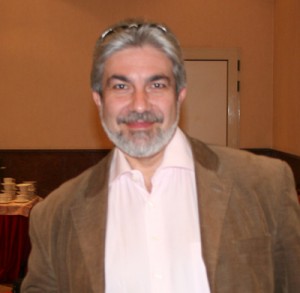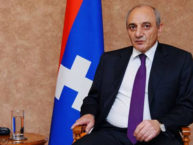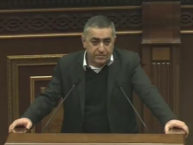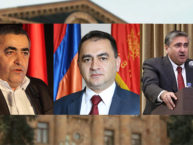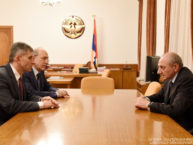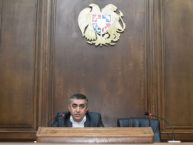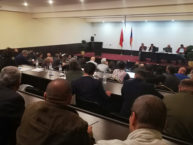Armenian Review
Volume 50 • Number 1-4 (Fall–Winter 2008)
When on April 7, 2006 the Armenians and the Left conference was launched in New York City, many asked what it would possibly be about. Yet the success of the event was such that the conference turned into political activism by, for instance, holding a seminar and creating a website to inform about the Israel-Hizbullah war of July of the same year. Most notably, however, the conference continued and expanded the following year, when a second meeting was organized on March 31, 2007 at Harvard University, as well as a broader gathering of committed U. S., Argentine, Uruguayan, and Brazilian intellectuals and activists on June 2 in Buenos Aires, Argentina. The latter was labeled Armenians and Progressive Politics at the Beginning of the 21st Century, and it is some of the papers presented at the latter conference that are published in this thematic issue of The Armenian Review opening a space for debate about a progressive approach to the Armenian Cause and Armenian politics in general.
Indeed, Armenians and the Left meant, first and foremost, beginning a discussion of progressive politics in the Armenian context redefining a commitment from a leftist perspective. Not surprisingly, the initiative for the Armenians and the Left came from political activists of the Armenian Revolutionary Federation-Dashnaktsutyun (ARF-D), a party committed to the Armenian national liberation struggle since the end of the 19th century. Yet, the initiative is not about party politics, nor does it limit the discussion to a specific topic. Quite the opposite, Armenians and the Left opened a space to include intellectuals, activists, and artists, both Armenian and non-Armenian, to link the national cause and national politics with progressive principles. It is, therefore, about the commitment to a national cause from a progressive perspective, as well as an invitation to review and renew the criteria of understanding, explaining, and taking sides about nearly all aspects of the Armenian reality. In this sense, Armenians and the Left urges a critical appraisal of the current course of Armenian life and politics both in the Republic of Armenia and the Diaspora.
To date, conventional wisdom placed the Armenian national cause beyond any ideological consideration. This was the case at least since 1965 when for the first time the three leading Armenian political parties in Diaspora, the Social Democrat Hunchakian, ARF-Dashnaktsutyun, and the Liberal Democrat Ramgavar, came together in an attempt to overcome ideological differences and other issues related to a leadership struggle in the community and united their efforts in claiming justice and reparations for the 1915–1923 Armenian Genocide. Twenty-three years later, in 1988, the Karabagh movement and, three years after that, the independence of Armenia, strengthened the commitment to the national cause beyond any ideological consideration. Moreover, the coming into being of independent statehood seemed to further consolidate this trend. Indeed, when it comes to the praxis of national politics, ideological neutrality is, and should be, the logical assumption for the course of political advocacy in Diaspora. There is, perhaps, even more reason when following Yerevan’s foreign policy agenda.
To be sure, it is not the aim of the Armenians and the Left space of debate to deny this logical assumption, nor to question its validity. Nevertheless, neither political advocacy nor state politics are defined in a vacuum. Decisions are made and implemented in national and international structural conditions and the outcome, politics, reflects the impact of the process of interaction of decisions with the dominant structures, which reproduce the power relationship in a given historical context. Structures, however, are not eternal; historical conditions do change, mostly as the result of actions undertaken by human actors, the agency that interact with the structure, who decide about the nature and the direction of change. The critical approach of Armenians and the Left to the current Armenian reality aims, precisely, at the identification of the power structures that since the end of Cold War and the independence of Armenia have dominated both in Armenia and Diaspora, imposing limitations on the fulfillment of national goals. What Armenians and the Left has so far shown is a wide interest, if not demand, for a critical approach to the Armenian reality in both Armenia and Diaspora. In this sense, it is the first intellectual input to discuss alternatives to the current course of Armenian politics.
Historically, progressive politics have been the vehicle for the internationalization of the Armenian Question since the last quarter of the 19th century. From the beginning, with the exception of the short-lived Armenagans, Armenian political parties were leftist organizations. Both the Social Democrat Hunchakian Party and the ARF-Dashnaktsutyun had a national and social agenda and defined the liberation struggle within the vision of the broader world socialist struggle. Most specifically the ARF-D, which became a full member of the Socialist International in 1907, made the national and social questions the two pillars of its political program. It was a socialist activist and representative of the French National Assembly, Jean Jaurés, who for the first time on November 3, 1896 called on Europe to assume its responsibility towards the Armenians. “In the name and under the responsibility of Europe, the European proletariat everywhere must take into its hands this cause,” he said. Moreover, under the leadership of the ARF-D, the dominant political force in the 1918-1920 Republic of Armenia, the construction of the first modern Armenian state aimed at a social-democratic model of politics and society. This was long before the coming of age of the welfare state or the widening of social and political rights for the sake of an inclusive and participatory democracy.
The sovietization of Armenia cut short this original initiative. The concept of ‘progress’ since then wore the straightjacket imposed by Communism. A sort of ideological monopoly was imposed as a social construction, and for several decades ‘progressive’ became a self-denomination of those who followed a strict Marxist-Leninist dogma, more precisely the political guidelines of the Communist Party of the Soviet Union. Naturally, any ‘progressive’ commitment in this context followed a logic dictated from Moscow. The particular space of national politics in the Armenian Diaspora thus had little room for any debate about progressiveness, as the term defined a line of fracture separating the pro-Soviets from those who were critical of the regime. The Cold War only deepened that fracture leading even to bloody confrontations.
An attempt at renewal came from the so-called ‘third generation’ of Diaspora Armenians in late 1960s and the 1970s. In the changing context of the Cold War and inspired by the emancipation of the Third World, the Civil Rights movement, and student mobilizations in U.S. and Europe, the ‘third generation’ championed a social and political rebellion against the essentially conservative Diaspora. Progressive politics surged onto the national agenda through a new commitment to the Armenian Cause in both the conceptual/theoretical and the practical meaning that characterized the 1975-1985 decade of struggle, often labeled as “armed propaganda.” Not surprisingly, the 20th World Congress of the ARF-D in 1972 marked a return to the socialist origins of the party, abandoning a once common, however wrong-headed and biased, identification with anti-Communism and anti-Sovietism though it never meant to stop being critical of both Communism and the Soviet regime. Much of the progressive debate in this period, however, was more a sort of social and cultural liberation befitting the sixties and seventies generations rather than any implementation on the ground of social politics, except, as mentioned, in the realm of the struggle for the Armenian Cause. Regardless of the influence of any of the political forces, almost all sectors in the Armenian Diaspora maintained their conservative understanding of communal life. Little, if anything, changed in the performance of community institutions, whether schools or community centers, the only space where national politics of a stateless people was then possible. Diaspora institutions showed no inclination for change, less for any progressive change that questioned the way national identity and politics were understood, preserved, and practiced since the early years of the conceptualization of the forced exile and the organization of dispersed communities.
Two factors in this critical period would have an impact in the following years. The first was the national awakening in Soviet Armenia starting in 1965. The consequence of the popular outcry for justice for the Genocide and “Our Lands! Our Lands!,” referring to Western Armenia and Nagorno Karabagh, was the birth and evolution of a dissident movement in the seventies. Following the path of other dissident movements in the former Soviet Union, Armenian dissidents demanded the implementation of the Helsinki Accords and formulated national demands from the perspective of human rights. Despite its sometimes dramatic turns, the dissident movement in Armenia had little impact on national politics; yet it helped to mature the idea of independence. The Diaspora has not been very receptive to the Armenian dissidents. In times of a particular ‘détente’ with the Soviet regime in Armenia, even if the nationalist commitment and sacrifice of the dissidents received some sympathy, prudence dominated. There was, thus, little if any connection between the dissident movement in Armenia and the Diaspora. Understandably, the dissident movement defined a meaning of ‘progress’ that was far from that of the then dominant Third-Worldist left-leaning progressives in Diaspora. This initial ideological distance between what at that time was progressive politics in Armenia and the way progressives in Diaspora understood their commitment, perhaps explains why progressive debate was almost absent during the transition from the Soviet regime.
The second factor was the westernization of the Diaspora with the massive migration of Armenians from the Middle East to Europe and North America following the Lebanese Civil War and the Islamic Revolution in Iran. Not only did the onetime ‘center’ of the Diaspora lose its weight in national affairs, but the emerging Armenian life in Europe and North America inevitably adopted the values and world-view of the dominant free-market ideology-driven process of globalization. If, on the one hand, Armenian politics in Diaspora became more professional in both the U.S. and Europe, where activists went through a learning process and successfully redefined their political insertion and engagement; the progressive approach of national renewal of the sixties and seventies became simply anachronistic with no practical implication for national politics.
The end of Cold War and the fall of the Soviet Union, the bankruptcy of the Communist experience in its Soviet model, the national liberation struggle in Nagorno Karabagh, the independence of Armenia, and especially the political and economic transition in the 1990s, left no room for any progressive debate. It seemed that Fukuyama’s “End of History” in terms of Right/Left was particularly true for the Armenian case. The self-proclaimed ‘progressive’ camp in Armenian politics, the Communists and their sympathizers in both Armenia and Diaspora, simply disappeared because their argument made no sense anymore. A tiny irruption of the debate was performed through the return of the ARF-D to Armenia. Though extremely prudent in dealing with a society where Socialism was understood only in Marxist-Leninist terms, the then leadership of ARF-D could not avoid an intellectual debate between those who were uneasy with this ideological identity of the party and those who finally saw an opportunity to implement a progressive agenda in the new social reality of Armenia. In fact, in the first four years of independence, the ARF-D tried to direct the course of the transition through a social-democratic path proposing, for instance, a parliamentary regime rather than a presidential one, the active engagement of the state in social policies, a soft-landing in the process of privatization, and so forth. This approach towards the transition, of course, ran against the interests of the then dominant Armenian National Movement (ANM) under the leadership of the first President, Levon Ter-Petrossian. An emerging political elite in Armenia was eager for a rapid privatization and total liberalization of the economy to assure its leading place and share in the newly forming capitalist class. As is well known, the crackdown on ARF-D and its prohibition in December of 1994 neutralized the only obstacle to a ‘shock-therapy’ style transition in Armenia. Even with the change of government in 1998 and the virtual vanishing of the AMN as a leading force in Armenia, practically nothing has changed in the socio-economic reality of the country. Quite the contrary, the model has deepened and created its enduring structures in terms of social and economic policies, class differences, political leadership, and international relations including with the Diaspora. Moreover, with a double-digit economic growth since 2002, Armenia has become almost a ‘poster child’ for the International Monetary Fund and the World Bank. With its return to the political arena in 1998 after its prohibition was lifted, the ARF-D forged an alliance with the newly elected Robert Kocharian and, for the next almost a decade, remained faithful to him especially during his most critical moments following the killing of then Prime Minister Vazgen Sargsian, Speaker of the National Assembly Karen Demirchian, and others in the parliament in October of 1999.
Yet, in July of 2002, the A.R.F. made an opening towards the much-needed debate about progressive politics in Armenia with the party’s leading body, the Bureau, organizing a conference about the Socialist agenda of the ARF-D in Armenia. The conference was meant to provide guidance for the party’s platform for the following year’s legislative elections. In 2003, the party accepted President Kocharian’s offer to be the junior partner of a coalition government along with the dominant parliamentary force, the Republican Party of Armenia, and the Country of Law (Orinats Yerkir) party. The commitment of the party to a socially progressive platform and its input in critical areas such as the struggle for the reduction of poverty in Armenia and the parliamentary debate about pensions notwithstanding, the ARF-D was understandably bound within the limits that the governing pact imposed. Not surprisingly, therefore, even for the activists in the party, critical questions about the level of engagement with executive power inevitably rose.
Armenians and the Left comes at a critical moment of international politics, Armenian national reality, and the ARF-D’s evolution. On the international level there has been the end of the Washington Consensus in 1999, the unilateralist turn in U.S. grand strategy following the declaration of the Global War on Terror in the aftermath of the terrorist attacks of September 11, 2001, and especially the formulation of the National Security Strategy in terms of preemption and its implementation with the military intervention in Iraq in 2003. There has also been the deepening of Europe’s dilemma in its process of expanding regional integration; the recuperation of Russia and the emergence of new regional powers –mainly Brazil, Russia, India, and China; the persistent militancy of Islamism, particularly its Sunni-Wahhabi version of Al Qaeda style Jihadism, and its challenge to world stability; the ‘Left turn’ in Latin America searching for new models of development other than free-market dogmatism; and last, but not least, a worldwide mobilization in the context of the World Social Forum aiming at “Another World is Possible.” These are events that clearly signal the bankruptcy of any unique model following the philosophy of the so-called “End of History.” Yet, on the national level, the echo of these changes seems more detectable in Diaspora than Armenia. Moreover not even the nearest turbulences, like the ‘color revolutions’ in Georgia and Ukraine, seem to affect politics in Armenia.
This does not mean, however, that essential questions ranging from Armenia’s national security in a broader sense, relations with Diaspora, and Turkish-Armenian relations have found adequate solutions. Quite the opposite as, despite the political turn in 1998, progress in all national questions has been rather slow. The Armenians and the Left initiative aims precisely to move forward in the direction of solutions, proposing a reinvigoration of debates that seem to have rather stagnated so far. As for the ARF-D’s current evolutionary stage and the role of Armenians and the Left, it has been mostly the party’s experience since 1998, and especially since 2003, as a partner in the government coalition that raises important issues for debate. There is no doubt that the process of institutionalizing a historically revolutionary party in Armenian politics has rapidly accelerated in the past ten years. Inevitably, therefore, the organizational and ideological challenges the party faces would press for debate. In fact, many intellectuals already directly or indirectly address these challenges and, in this sense, Armenians and the Left is meant to be yet another forum pushing forward the discussion about these challenges that are marking the evolution of the party.
Understandably, the Armenian Cause and Turkish-Armenian relations are at the heart of the concerns of the Armenians and the Left initiative. From a critical perspective, we can distinguish nationalist, free-market, and progressive approaches to the Armenian Cause at the heart of which lies the issue of the Genocide and Turkish-Armenian relations. While there are no clear-cut frontiers separating the three approaches, it is possible, if not necessary, to underline the differences to more effectively implement a political course. Thus the traditional, and somehow easy, approach to the Genocide and Turkish-Armenian relations has been the nationalist perspective. In its most simplistic form, the nationalist approach sees little hope for a Turkish-Armenian rapprochement. This is most clearly seen in Turkish denial of the Genocide and further in Turkish anti-Armenian aggressiveness. Armenian nationalism is in general a reaction to Turkish nationalism, and it exhibits extreme prudence when dealing with Turks. It is based on the historical experience of a victim trying to avoid falling into the trap of a political project that has never abandoned the aim of exterminating the Armenians. Turkish-Armenian relations from the nationalist perspective are characterized as enmity relations and, indeed, Turkish-Azerbaijani military cooperation against Armenia leaves little doubt about the truth of this characterization. Overall, however, a narrow nationalist approach to the Armenian Cause could shut the door to any positive developments that could open the way to a dialogue with the most democratic and progressive sectors of Turkish society. Such isolation is certainly not helpful to the Armenian Cause and in the long run could even be harmful.
The free-market approach is the novel perspective that came into being with independence in 1991 and was the dominant ideological profile of the leadership that assumed the responsibility of governing in the years of political and economic transition. In fact, though ideologically it assumes extreme liberal positions, the free-market approach follows the same argument that the Soviet regime used to avoid any official recognition of the Armenian Genocide: good neighbor relations with Turkey. Without falling into the trap of denialism the free-market, or as some label it ‘pragmatic,’ approach to Turkish-Armenian relations silences the claims for recognition and reparation in the name of a so-called ‘raison d’Etat’ and gives priority to unconditional relations. The error of those who rationalized this approach and made it official policy is twofold. On the one hand, they do not see the widespread rejection within the Armenian reality, in Diaspora and Armenia, of any inclination towards consigning to oblivion the 1915 Catastrophe. On the other hand, they fail to admit that it is actually Turkey that conditions any relationship by demanding, among other things, an official abandonment of the demand for recognition of the Genocide. The free-market approach is not exclusive to the followers of Levon Ter-Petrossian or to controversial intellectuals such as Ronald Suny, Ktritch Sardarian or Gerard Libaridian. The failed initiative of the Turkish-Armenian Reconciliation Commission (TARC) had the backing of the US State Department, the active participation of the Armenian Assembly, and the tacit agreement of Yerevan. It aimed to replace ‘recognition’ and ‘reparation’ with ‘reconciliation,’ and thus engage a path of practical forgetting; it also emphasized an artificial differentiation between the Armenians of Armenia and the Armenians of Diaspora, making the latter solely responsible for the persistence of Turkish-Armenian controversy. In the end, it bet on the opening of the Turkish-Armenian border and assumed that the flow of goods and people would eventually create new interests that would play a leading role in any politicization of the Armenian Genocide up to its final destiny as a perpetual ‘historical’ dispute irrelevant in real-world politics. TARC failed not only because of the mercenary nature of its main players, who were unrepresentative of either Turkish or Armenian society, but mostly because of Ankara’s determination to use any Turkish-Armenian forum only for the purpose of its denialist policy. The failure of TARC notwithstanding, the free-market approach still survives in Armenian reality; though it is circumscribed to a minority sector, it nevertheless can always be instrumentalized in the dynamics of Armenian domestic politics and used by third parties.
The progressive perspective of the Armenian Cause is both an alternative to the free-market approach and a reformulation of the traditional nationalist position liberated from its isolationist impulse. The recognition of the Armenian Genocide and reparations for the crime are still at the heart of the progressive approach that, however, makes two important openings. First, it engages in a dialogue with Turkish progressive intellectuals and welcomes any initiative from Turkish society in terms of questioning the official version of history and, eventually, recognizing responsibility for the Genocide. Second, it inserts the Armenian Cause into the broader context of a universal engagement to prevent any genocide in any part of the world in the future. In this sense, the progressive approach to the Armenian Cause considers it a moral duty for any Armenian, as the descendent of a people victimized by genocide, to speak out against any crime against humanity.
Khatchik Der Ghoukassian is a professor at the Universidad de San Andresin in Argentina and a visiting professor at the American University of Armenia. He received his doctorate in International Studies at the University of Miami (Florida) and holds a Masters in International Relations from FLACSO/Argentina. From 1987 to 1997 he was the editor of the Armenia newspaper in Buenos Aires, Argentina.

